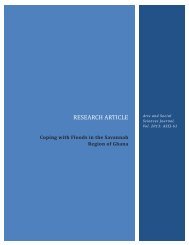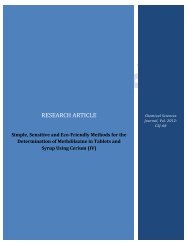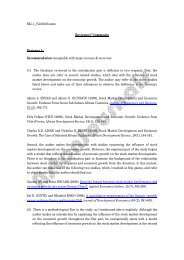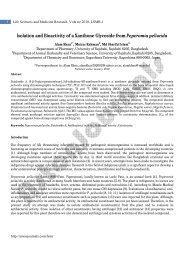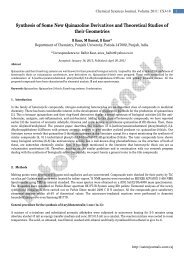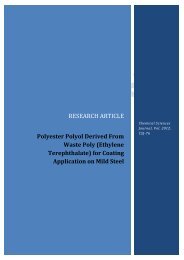The Firm as an Institution for Product Design and ... - AstonJournals
The Firm as an Institution for Product Design and ... - AstonJournals
The Firm as an Institution for Product Design and ... - AstonJournals
- No tags were found...
Create successful ePaper yourself
Turn your PDF publications into a flip-book with our unique Google optimized e-Paper software.
2 Review ArticleAn authority – the m<strong>an</strong>ager of a firm – c<strong>an</strong> reduce these tr<strong>an</strong>saction costs by acting <strong>as</strong> a centre <strong>for</strong>communication <strong>an</strong>d by centralizing decision making, clarifying the contributions expected by eachparticip<strong>an</strong>t, the rewards <strong>an</strong>d the s<strong>an</strong>ctions.Asset-specific investments (also termed tr<strong>an</strong>saction- or relation-specific investments) provide<strong>an</strong>other expl<strong>an</strong>ation to why economic activities are integrated into the unified hierarchical govern<strong>an</strong>cestructure of firms [5–7]. If one party invests in <strong>an</strong> <strong>as</strong>set that is specifically adapted to <strong>an</strong>otherparty, they both become dependent on each other. A few party exch<strong>an</strong>ge problem arises in whicheach party risks to become the victim in a “hold-up” situation. Again, the risk of opportunistic behaviour(moral hazard) calls <strong>for</strong> a unified govern<strong>an</strong>ce that centralizes <strong>an</strong>d integrates interdependentstages of production processes, especially if tr<strong>an</strong>sactions are frequent <strong>an</strong>d there are uncertaintiesinvolved [7].A related theory of the firm emph<strong>as</strong>izes the distribution of property rights [8]. According tothis view the ownership of non-hum<strong>an</strong> resources defines the firm. One re<strong>as</strong>on <strong>for</strong> ownership is,again, the existence of <strong>as</strong>set-specific investments. Ownership of <strong>as</strong>set-specific investments enablesthe firm to secure future control, which reduces the risk of future bargaining problems <strong>an</strong>d securesfuture residual incomes. Ownership is chosen when its benefits (control <strong>an</strong>d residual rights) exceedthe benefits of using alternative market contracts. Again, firms use incomplete contracts <strong>an</strong>d claimresidual rights because it is difficult to, ex <strong>an</strong>te, specify outcomes <strong>an</strong>d rewards. <strong>The</strong> principal is giventhe right to direct other parties’ activities <strong>an</strong>d is rewarded with residual incomes [9–11].Another expl<strong>an</strong>ation emph<strong>as</strong>ises the use of knowledge in firms (in<strong>for</strong>mation, capabilities<strong>an</strong>d competence). Specific, unique knowledge is difficult to protect <strong>an</strong>d exploit in market tr<strong>an</strong>sactions.<strong>The</strong> seller risks losing control of the knowledge when it is sold <strong>an</strong>d if the knowledge spreads,its value deteriorates [12]. From this point of view, the firm is <strong>an</strong> institution that develops, protects,tr<strong>an</strong>sfers <strong>an</strong>d integrates specific knowledge [7, 13–15]. This view c<strong>an</strong> be related to theoretical traditionsemph<strong>as</strong>izing capabilities that are unique to the firm, such <strong>as</strong> evolutionary economics [16]<strong>an</strong>d the resource-b<strong>as</strong>ed view of the firm [17]. For a discussion on knowledge-b<strong>as</strong>ed approaches tothe firm, see Foss [18].<strong>The</strong> different approaches described above provide various expl<strong>an</strong>ations to why tr<strong>an</strong>sactioncosts c<strong>an</strong> be reduced if they are internalized within the hierarchy of a firm. But, of course, thereare limits to internalization <strong>an</strong>d tr<strong>an</strong>saction costs sometimes are higher in firms th<strong>an</strong> in markets.One problem in firms is that outcomes c<strong>an</strong> be difficult to me<strong>as</strong>ure. <strong>The</strong>re<strong>for</strong>e, rewards have to beb<strong>as</strong>ed on me<strong>as</strong>ures other th<strong>an</strong> output, creating hierarchical incentives that are weak <strong>an</strong>d bi<strong>as</strong>edcompared to market incentives [7]. Another problem is that agents c<strong>an</strong> have in<strong>for</strong>mation adv<strong>an</strong>tagescompared to principals, which may give rise to moral hazard/opportunism within firms. Suchagency problems raise the question of efficient control in firms [7, 19, 20]. One solution is to developfirm-internal market mech<strong>an</strong>isms, <strong>as</strong> illustrated by piece-rate payments <strong>an</strong>d profit centres [7].Another solution is to develop trust between agent <strong>an</strong>d principals to mitigate the risk of opportunisticbehaviour. Trust characterizes intermediate institutions such <strong>as</strong> cl<strong>an</strong>s <strong>an</strong>d networks [21–24].A third problem occurs in multit<strong>as</strong>k situations, when <strong>an</strong> agent per<strong>for</strong>ms different kinds of work<strong>an</strong>d some t<strong>as</strong>ks are me<strong>as</strong>urable where<strong>as</strong> others are not. Here the situation becomes especiallyproblematic [25].<strong>The</strong> contributions explain the choice of institutional structure from a tr<strong>an</strong>saction cost perspective,stressing problems due to imperfect in<strong>for</strong>mation, bounded rationality <strong>an</strong>d behavioural risks. Asomewhat different approach is to study how the choice of coordinative mech<strong>an</strong>isms encouragesdifferent kinds of behaviour. Roberts [26] argues that market-oriented incentives in firms encourageemployees to explore new opportunities <strong>an</strong>d to be innovative. On the other h<strong>an</strong>d, hierarchicalmech<strong>an</strong>isms encourage cooperation <strong>an</strong>d the exploitation of existing adv<strong>an</strong>tages. Roberts also notesthat trust between the involved parties c<strong>an</strong> exp<strong>an</strong>d the trade-off between innovative <strong>an</strong>d cooperativebehaviour.<strong>AstonJournals</strong>http://<strong>as</strong>tonjournals.com/bejCo-Publisher: OMICS Group, www.omicsonline.org
4 Review ArticleJarillo [30] presented a similar view <strong>an</strong>d identified the “strategic network” <strong>as</strong> a specific typeof interorg<strong>an</strong>izational relationship in which a central “hub firm” acts <strong>as</strong> a network orchestrator whocoordinates relations to other firms. Jarillo used tr<strong>an</strong>saction cost economics to <strong>an</strong>alyse the phenomenon<strong>an</strong>d identified strategic networks <strong>as</strong> a coordinative mode besides markets, bureaucracies<strong>an</strong>d cl<strong>an</strong>s. <strong>The</strong> hub firm develops long-term trust among disintegrated actors in a network of marketrelations <strong>an</strong>d reaps greater benefits of specialization, flexibility <strong>an</strong>d cost discipline th<strong>an</strong> integratedfirms. <strong>The</strong> perspective of strategic networks later became <strong>an</strong> interest <strong>for</strong> various fields of research<strong>an</strong>d h<strong>as</strong> since been used <strong>for</strong> <strong>an</strong>alysing industry structure, market power <strong>an</strong>d firm positioning within<strong>an</strong> industry [31], <strong>as</strong> well <strong>as</strong> firm value <strong>an</strong>d knowledge creation [31–33]. <strong>The</strong> benefits developed bystrategic networks, compared to alternative systems of pure market relations, were described <strong>as</strong>“non-zero-sum games” <strong>an</strong>d “opportunity of joint-value creation” [30]. <strong>The</strong> <strong>an</strong>alysis discuss how thehub coordinates (trustful vs. arm’s length market relations), but the economic function per<strong>for</strong>med bythe hub in the first place is not theoretically <strong>an</strong>alysed.Rugm<strong>an</strong> <strong>an</strong>d D’Cruz [34] also identified the import<strong>an</strong>ce of firms that act <strong>as</strong> centres in largercontexts of suppliers <strong>an</strong>d customers, using the concept of “flagship firms.” Flagship firms developrelations to key suppliers <strong>an</strong>d customers <strong>an</strong>d implement a strategy <strong>for</strong> a larger network of firms. <strong>The</strong>flagship:…determines <strong>an</strong>d sets limits to the product/markets in which its network partners will beallowed to operate, it chooses the courses of action they will adopt to develop competenciesin these fields of endeavor <strong>an</strong>d it directs their capital investment programs. In return, networkpartners are given membership in the flagship’s network which usually carries with it prospectsof signific<strong>an</strong>t sales volumes, access to adv<strong>an</strong>ced technology <strong>an</strong>d participation in the benefitsof the br<strong>an</strong>d-image of the flagship.[34, p. 405]Also Rugm<strong>an</strong> <strong>an</strong>d D’Cruz used a tr<strong>an</strong>saction cost <strong>an</strong>alysis to describe how flagship firms <strong>an</strong>dnetwork partners coordinate. <strong>The</strong>y explained the relations <strong>as</strong> long-term, collaborative <strong>an</strong>d differentfrom the short-term competitive relations in traditional markets <strong>an</strong>d different from the internal relationsin large divisionalized corporations. <strong>The</strong> flagship firm is described <strong>as</strong> providing leadership <strong>an</strong>dstrategy to the network. But – again – why these functions are per<strong>for</strong>med by a specialized firm is not<strong>an</strong>alysed.<strong>The</strong> same lack of theoretical expl<strong>an</strong>ation is found in the discussion of firms that per<strong>for</strong>m therole of “system integrator”, <strong>as</strong> illustrated by Hobday et al. [35]. In their <strong>an</strong>alysis, specialized firmswith capabilities to design <strong>an</strong>d integrate systems <strong>an</strong>d m<strong>an</strong>age networks of components <strong>an</strong>d subsystemsuppliers, are identified. <strong>The</strong> authors conclude that the more complex, high-tech <strong>an</strong>d costlythe product, the more signific<strong>an</strong>t system integration becomes. However, why this is the c<strong>as</strong>e is notexplained.Christensen et al. [36] <strong>an</strong>alyse disruptive technologies <strong>an</strong>d identify disintegrated firms at thelater stages of product evolution, when modulation <strong>an</strong>d clearly defined interfaces between components<strong>an</strong>d subsystems are clearly specified. Disintegrated firms come into the picture at a stage ofdevelopment when integration is no longer necessary. <strong>The</strong>se comp<strong>an</strong>ies “mix <strong>an</strong>d match the best componentsfrom the best suppliers to respond to the specific needs of individual customers” [36, p. 76].Hence, the industrial logic shifts from large, vertically integrated firms competing with continuousimprovements, to firms that are more specialized in horizontal dimensions of the value chain competingwith price, flexibility <strong>an</strong>d speed. Why firms specializing in “mix <strong>an</strong>d match” are needed is not<strong>an</strong>alysed further. Argyres <strong>an</strong>d Bigelow [37] continue this approach <strong>an</strong>d relate it to tr<strong>an</strong>saction coststheory. <strong>The</strong>y explain vertical integration in its early stages <strong>as</strong> a result of <strong>as</strong>set specificity <strong>an</strong>d theinterdependencies that exist when complex new system products are built. As components become<strong>AstonJournals</strong>http://<strong>as</strong>tonjournals.com/bejCo-Publisher: OMICS Group, www.omicsonline.org
Business <strong>an</strong>d Economics Journal, Vol. 2013: BEJ-855more st<strong>an</strong>dardized, <strong>as</strong>set specificity is reduced; hence, production becomes more disintegrated. <strong>The</strong><strong>an</strong>alysis illustrates how the rationality <strong>for</strong> integration ch<strong>an</strong>ges <strong>as</strong> new innovations develop, but alsoin this c<strong>as</strong>e, there is no expl<strong>an</strong>ation <strong>for</strong> why firms are needed, beyond internalization.That there is more to the economic function of the firm th<strong>an</strong> internalization is illustrated bythe number of import<strong>an</strong>t firms that influence activities far beyond the scope of their hierarchies <strong>an</strong>dby firms that are extremely disintegrated. An example is Nike, a global market leader in athleticfootwear. Nike keeps the design of new products <strong>an</strong>d marketing activities to retailers in-house,but relies on well m<strong>an</strong>aged market relations to coordinate production <strong>an</strong>d distribution [38]. Otherexamples of disintegrated firms are H&M in the f<strong>as</strong>hion industry <strong>an</strong>d Hewlett Packard in the electronicsindustry, firms that compete with integrated firms in their respective industries [39].As illustrated above, firms specialize in functions other th<strong>an</strong> hierarchical govern<strong>an</strong>ce, functionswhich are neglected in the comparative institutional <strong>an</strong>alysis of the firm. Some researchers inadjacent fields describe boundary-sp<strong>an</strong>ning firms <strong>an</strong>d disintegrated firms <strong>an</strong>d <strong>an</strong>alyse their relationsto suppliers <strong>an</strong>d customers by the use of a comparative institutional <strong>an</strong>alysis, but there is nocomparative institutional <strong>an</strong>alysis of the economic function of these firms.3. <strong>The</strong> EntrepreneursIn neocl<strong>as</strong>sical economic theory, the entrepreneur/m<strong>an</strong>ager determines qu<strong>an</strong>tities of input <strong>an</strong>d products.Price signals guide these decisions <strong>an</strong>d determine trade-off between the alternatives. However,<strong>as</strong> early writers on entrepreneurship observed, entrepreneurs also per<strong>for</strong>m the import<strong>an</strong>t t<strong>as</strong>ks ofdeveloping new products, finding new ways to combine resources <strong>an</strong>d putting them into practice[40]. In addition, entrepreneurs h<strong>an</strong>dle uncertainties related to new unpredictable ventures [41] <strong>an</strong>dspecialize in making judgmental decisions [42]. Later theories on entrepreneurship discuss whatentrepreneurs do <strong>an</strong>d the personal characteristics of entrepreneurs, <strong>as</strong> illustrated by C<strong>as</strong>son [43],who suggests entrepreneurship <strong>as</strong> a b<strong>as</strong>is <strong>for</strong> synthesizing theories of the firm. C<strong>as</strong>son identifiesthe entrepreneur <strong>as</strong> a market maker, <strong>an</strong> “originator” who comes up with new ide<strong>as</strong> <strong>an</strong>d <strong>an</strong> “org<strong>an</strong>izer”who realizes them. C<strong>as</strong>son argues that entrepreneurs have a specific kind of judgment due tosuperior access to in<strong>for</strong>mation, a relative optimism, self-confidence, low risk-aversion, <strong>an</strong> effectivesocial network <strong>an</strong>d a reputation <strong>for</strong> honesty. Hereby, C<strong>as</strong>son continues a tradition that focuses on,who becomes <strong>an</strong> entrepreneur, the specific psychology, etc., rather th<strong>an</strong> why there is a need <strong>for</strong> <strong>as</strong>pecialized entrepreneur in the market system in the first place.A comparative institutional approach h<strong>as</strong> been used to compare decisions made by entrepreneurswith decisions made by centralized bureaucracies in pl<strong>an</strong>ned economies, <strong>as</strong> w<strong>as</strong> earlydiscussed by von Mises [44] <strong>an</strong>d Hayek [45]. However, a comparative institutional <strong>an</strong>alysis of theentrepreneur within the market system needs to be developed. <strong>The</strong> alternative to the specializedentrepreneurial function in such a system is the individual customer <strong>an</strong>d producer <strong>an</strong>d the questionis why a specialized agent sometimes per<strong>for</strong>ms these functions more efficiently. Entrepreneurialtheories take entrepreneurs <strong>for</strong> gr<strong>an</strong>ted <strong>an</strong>d neglect such alternative solutions to the market-makingproblem. A comparative institutional <strong>an</strong>alysis needs to explain why a specialized entrepreneurialfunction c<strong>an</strong> be efficient compared to alternative solutions, <strong>an</strong> <strong>an</strong>alysis that would provide a b<strong>as</strong>is<strong>for</strong> a theory of disintegrated firms.<strong>The</strong> argument here is that the function per<strong>for</strong>med by disintegrated br<strong>an</strong>d-name firms issimilar to the function per<strong>for</strong>med by entrepreneurs. <strong>The</strong>re<strong>for</strong>e it should be <strong>an</strong>alysed in comparisonwith individual customers <strong>an</strong>d producers. <strong>The</strong> adv<strong>an</strong>tages of disintegrated firms c<strong>an</strong> be traced totwo different economic functions: the design function, in which a disintegrated br<strong>an</strong>d-name firmacts <strong>as</strong> a specialized agent who designs a product, <strong>an</strong>d the orchestration function, in which a disintegratedbr<strong>an</strong>d-name firm is a specialized value chain coordinator, residual claim<strong>an</strong>t <strong>an</strong>d qualitycontroller. A conclusion is that disintegrated br<strong>an</strong>d-name firms reduce tr<strong>an</strong>saction costs compared<strong>AstonJournals</strong>Co-Publisher: OMICS Group, www.omicsonline.orghttp://<strong>as</strong>tonjournals.com/bej
6 Review Articleto individual customers <strong>an</strong>d input owners in the realization of complex <strong>an</strong>d composite products,products that the customers never knew they would dem<strong>an</strong>d <strong>an</strong>d suppliers never knew they wouldsupply. This discussion will be elaborated below.4. <strong>Product</strong> <strong>Design</strong>Among the few economic researchers who had observed these entrepreneurial functions in a comparativesetting are Cheung [46] <strong>an</strong>d McNulty [47]. Cheung [46] discussed composite products, withseveral inputs <strong>an</strong>d combined producers <strong>an</strong>d observed that it c<strong>an</strong> be costly <strong>for</strong> individual customers<strong>an</strong>d producers to me<strong>as</strong>ure all contributions <strong>an</strong>d prices. Cheung summarized his arguments <strong>as</strong>follows:In principle, all contributions of producers <strong>as</strong> well <strong>as</strong> the services of the coordinator c<strong>an</strong> beseparately priced <strong>an</strong>d sold to customers by me<strong>as</strong>uring directly various attributes related toeach contribution. In this c<strong>as</strong>e product <strong>an</strong>d factor markets coincide. But the determinationof prices is costly because of the numbers of tr<strong>an</strong>sactions, because consumers lack detailedin<strong>for</strong>mation on the use of each component or contribution to a commodity, because of thedifficulty of me<strong>as</strong>uring varied <strong>an</strong>d ch<strong>an</strong>ging activities <strong>an</strong>d because of the need to separatecontributions.[46, p. 9]Cheung <strong>an</strong>alysed the firm <strong>as</strong> a coordinative function that specializes in deciding whichcomponents to use, me<strong>as</strong>uring contributions <strong>an</strong>d discovering prices. McNulty [47] added to thisapproach by dividing economic activities into two kinds: tr<strong>an</strong>s<strong>for</strong>mation of resources into goods <strong>an</strong>dexch<strong>an</strong>ge of goods <strong>for</strong> other goods or money. Decisions on the qualitative dimensions of a productc<strong>an</strong>not be made solely by market exch<strong>an</strong>ges. Deciding on tr<strong>an</strong>s<strong>for</strong>mation is <strong>an</strong> economic activity initself which requires resources (in<strong>for</strong>mation, skills <strong>an</strong>d creativity) <strong>an</strong>d here we find <strong>an</strong> expl<strong>an</strong>ation<strong>for</strong> why firms exist. McNulty writes:<strong>The</strong> determination of quality is a unique province. <strong>The</strong> qualitative dimensions of goods /…/ c<strong>an</strong>be traded <strong>an</strong>d priced, but not determined or ch<strong>an</strong>ged, within the network of market relationships.<strong>The</strong> market provides <strong>an</strong> arena in which consumers c<strong>an</strong> accept a certain product /…/. But itrequires the org<strong>an</strong>ization we call a firm to determine which of these, or of something else, willin fact be available in the market.[47, p. 248]Cheung <strong>an</strong>d McNulty describe the firm <strong>as</strong> specialized in developing knowledge about components,input prices <strong>an</strong>d in deciding the various qualitative dimensions of products. But these insights haveneither prevailed in the theoretical <strong>an</strong>alysis of the firm, nor in the theoretical <strong>an</strong>alysis of entrepreneurs.In this paper, “product design” describes decisions about what product to produce <strong>an</strong>d howto produce it. <strong>The</strong>se decisions must be made be<strong>for</strong>e the physical modelling of a product is done <strong>an</strong>dbe<strong>for</strong>e the product is exch<strong>an</strong>ged in the market. <strong>The</strong> design of a product is part of the tr<strong>an</strong>sactioncosts <strong>an</strong>d a question is how these costs c<strong>an</strong> be reduced. Cheung <strong>an</strong>d McNulty see this function <strong>as</strong>the re<strong>as</strong>on <strong>for</strong> firms in a market economy. But is it evident that design is a function that should beper<strong>for</strong>med by a specialized agent? A comparative institutional <strong>an</strong>alysis h<strong>as</strong> to consider alternativesolutions to the problem of design.In principle, product design c<strong>an</strong> be decided in three ways. <strong>The</strong> customer, being the receiverof the good, c<strong>an</strong> decide on the design <strong>an</strong>d communicate it to a producer/input owner. Alternatively,a producer/input owner, being the supplier of the good, c<strong>an</strong> decide on the design, produce the<strong>AstonJournals</strong>http://<strong>as</strong>tonjournals.com/bejCo-Publisher: OMICS Group, www.omicsonline.org
Business <strong>an</strong>d Economics Journal, Vol. 2013: BEJ-857product, <strong>an</strong>d then offer it to the customer. Or, a specialized agent – a disintegrated br<strong>an</strong>d-name firm –c<strong>an</strong> act <strong>as</strong> <strong>an</strong> intermediary <strong>an</strong>d make the decision.All three alternatives are possible, but we lack a theoretical expl<strong>an</strong>ation of the choice betweenthem. Below follows <strong>an</strong> attempt to sketch a comparative institutional <strong>an</strong>alysis. In<strong>for</strong>mation <strong>as</strong>ymmetriesprovide a start <strong>for</strong> the <strong>an</strong>alysis. Customers have in<strong>for</strong>mation adv<strong>an</strong>tages when it comes toknowing their own personal preferences <strong>an</strong>d budget restraints. On the other h<strong>an</strong>d, producers havethe best in<strong>for</strong>mation about their own available resources, production possibilities <strong>an</strong>d costs. If thedem<strong>an</strong>d-side of this in<strong>for</strong>mation problem is more complex (difficult <strong>for</strong> <strong>an</strong>other party to comprehend),the customer h<strong>as</strong> relative in<strong>for</strong>mation adv<strong>an</strong>tages in per<strong>for</strong>ming the design function <strong>an</strong>d viceversa. However, product design requires more th<strong>an</strong> in<strong>for</strong>mation about customer preferences <strong>an</strong>dproduction possibilities <strong>an</strong>d designing a product c<strong>an</strong> benefit m<strong>an</strong>y customers <strong>an</strong>d input owners.<strong>The</strong>re<strong>for</strong>e, product design is <strong>an</strong> activity in which <strong>an</strong> actor c<strong>an</strong> gain adv<strong>an</strong>tages by specializing <strong>an</strong>dmaking investments <strong>an</strong>d then sharing the costs among m<strong>an</strong>y customers <strong>an</strong>d producers.However, using a specialized firm to solve the design problem comes at a cost. Individualcustomers <strong>an</strong>d producers have the best knowledge of their own preferences <strong>an</strong>d possibilities,knowledge that the firm needs to develop. This implies that <strong>an</strong> actor will specialize in per<strong>for</strong>ming thedesign function when it requires specific skills <strong>an</strong>d subst<strong>an</strong>tial ef<strong>for</strong>ts, especially when these ef<strong>for</strong>tsc<strong>an</strong> be shared among several customers <strong>an</strong>d/or several producers. <strong>The</strong> efficiency of this activity c<strong>an</strong>be explained by two kinds of adv<strong>an</strong>tages: the possibility to pool dem<strong>an</strong>d <strong>an</strong>d the possibility to obtaincombinational positive externalities among integrated producers.First, the adv<strong>an</strong>tages of pooling dem<strong>an</strong>d: scale adv<strong>an</strong>tages are often <strong>as</strong>sociated with largephysical investments, but they are import<strong>an</strong>t <strong>for</strong> efficiency in all activities where fixed costs aresubst<strong>an</strong>tial. To the extent that design requires large investments <strong>an</strong>d satisfy m<strong>an</strong>y customers, <strong>as</strong>pecialized agent c<strong>an</strong> specialize in the activity <strong>an</strong>d spread the cost among all users, to their mutualbenefit. Hypothetically, a customer who dem<strong>an</strong>ds a new product c<strong>an</strong> decide on the design himself/herself. But this might entail <strong>an</strong> enormous ef<strong>for</strong>t <strong>an</strong>d require specialized knowledge about existing<strong>an</strong>d future production possibilities <strong>an</strong>d input prices <strong>an</strong>d the skills needed to combine <strong>an</strong>d developthese possibilities. If a product is complex (m<strong>an</strong>y quality dimensions <strong>an</strong>d difficult to comprehend)<strong>an</strong>d composite (the result of m<strong>an</strong>y different inputs), high tr<strong>an</strong>saction costs will prevent customersfrom per<strong>for</strong>ming this function. In this c<strong>as</strong>e, it is more efficient to introduce <strong>an</strong> actor who specializesin deciding on the design.<strong>Product</strong> design is a semi-public good. <strong>The</strong>re is no direct rivalry in consumption; the samedesign c<strong>an</strong> be used in infinite products, but potential users c<strong>an</strong> be excluded by the protection of thedesign (keeping it a secret, <strong>as</strong>serting intellectual property rights <strong>an</strong>d other me<strong>as</strong>ures). Here, a specializedactor c<strong>an</strong> invest in a design <strong>an</strong>d then offer it to m<strong>an</strong>y customers in a controlled way, dividingthe cost among them <strong>an</strong>d making <strong>an</strong> additional profit. This way, the customer benefits from beingoffered a new product design at a fraction of its total cost.A disadv<strong>an</strong>tage of having a specialized agent designing <strong>for</strong> m<strong>an</strong>y users is that it may notfit individual customer needs <strong>as</strong> well <strong>as</strong> a tailor-made design would. This possible deviation cost ofm<strong>as</strong>s consumption is a disadv<strong>an</strong>tage to be weighed against the benefits of a specialized function.Similar adv<strong>an</strong>tages <strong>an</strong>d disadv<strong>an</strong>tages occur if the perspective shifts <strong>an</strong>d <strong>an</strong> actor who specializesin design is compared to <strong>an</strong> individual producer. Assume that each of several producers c<strong>an</strong> producethe same new product <strong>an</strong>d sell it in the market. Each producer c<strong>an</strong> invest in the design <strong>an</strong>dthen produce the product, or have someone else specialize in the function acting <strong>as</strong> a proxy <strong>for</strong> allproducers. <strong>The</strong> adv<strong>an</strong>tage of the latter solution is that a specialized actor c<strong>an</strong> offer the same designto all producers, share the cost among them, <strong>an</strong>d make a profit. If the costs of design are large <strong>an</strong>d ifthere is sufficient dem<strong>an</strong>d, each particip<strong>an</strong>t c<strong>an</strong> gain from such a solution. One disadv<strong>an</strong>tage <strong>for</strong> theindividual producer is deviation costs that occur if the design does not fit the individual producer’sproduction possibilities.<strong>AstonJournals</strong>Co-Publisher: OMICS Group, www.omicsonline.orghttp://<strong>as</strong>tonjournals.com/bej
10 Review ArticleFurthermore, a firm specializing in orchestration will have in<strong>for</strong>mation adv<strong>an</strong>tages comparedto customers which give rise to various problems. A first problem is costs of market communicationsince the orchestrator h<strong>as</strong> to in<strong>for</strong>m customers about new products <strong>an</strong>d customers have to in<strong>for</strong>mthemselves about opportunities. Second, the orchestrator’s in<strong>for</strong>mation adv<strong>an</strong>tages c<strong>an</strong> potentiallygive rise to opportunistic behaviour (moral hazard). <strong>The</strong> orchestrator c<strong>an</strong> be dishonest about thequalities of the product <strong>an</strong>d customers may be reluct<strong>an</strong>t to pay <strong>for</strong> quality they c<strong>an</strong>not verify be<strong>for</strong>eh<strong>an</strong>d[48]. This problem c<strong>an</strong> be solved by signalling or screening activities, where costs must beweighed against the benefits of the orchestrating function. Signalling activities enable the orchestratorto communicate the quality, <strong>for</strong> example, by labelling the product with a br<strong>an</strong>d. Screening,on the other h<strong>an</strong>d, covers methods that customers use to sort out variations in quality. Br<strong>an</strong>ds areimport<strong>an</strong>t here too. Without them, customers would have difficulties evaluating different products.A satisfied customer will connect a positive experience to the br<strong>an</strong>d <strong>an</strong>d communicate it to othercustomers. Likewise, dissatisfied customers will erode the br<strong>an</strong>d’s reputation. Thus, in<strong>for</strong>mation<strong>as</strong>ymmetries motivate signalling <strong>an</strong>d screening ef<strong>for</strong>ts, which is <strong>an</strong>other re<strong>as</strong>on why disintegratedbr<strong>an</strong>d-name firms are the holders of br<strong>an</strong>d-name rights.Now turn to the supply side. An individual producer c<strong>an</strong> contract with other input owners,including a firm that makes the design <strong>an</strong>d produce a composite product without involving<strong>an</strong>y intermediate specialized actor. However, this me<strong>an</strong>s the producer will have tr<strong>an</strong>saction costs<strong>for</strong> identifying other potential input owners <strong>as</strong> well <strong>as</strong> customers. Again, especially <strong>for</strong> compositeproducts, the costs <strong>for</strong> searching partners <strong>an</strong>d negotiating contracts will be subst<strong>an</strong>tial, <strong>as</strong>will costs <strong>for</strong> controlling <strong>an</strong>d en<strong>for</strong>cing agreements. An intermediate orchestrator c<strong>an</strong> share fixedtr<strong>an</strong>saction costs among input owners <strong>an</strong>d create gains <strong>for</strong> all. But again, a possible disadv<strong>an</strong>tage<strong>for</strong> individual producers is the potential costs due to deviations from individual productionpossibilities.In a world with imperfect in<strong>for</strong>mation, the coordination of dispersed producers <strong>an</strong>d customersis a risky venture. How c<strong>an</strong> the risk be allocated between customers, producers <strong>an</strong>d the orchestrator?One solution is to offer customers <strong>an</strong> open contract where they pay whatever is requiredto cover the costs <strong>for</strong> inputs. <strong>The</strong> contract could include in<strong>for</strong>mation on <strong>an</strong> estimated price, butalso state that if deviations occur the customer h<strong>as</strong> to pay more or less depending on the finalcosts. Another solution is to let producers carry the risk, specifying their contributions but allowingrewards to be adjustable, depending on the revenues created when selling the product. A final solution,<strong>an</strong>alysed by Fama [19] <strong>an</strong>d Fama <strong>an</strong>d Jensen [20, 49] is to let <strong>an</strong> intermediate be the risk taker.This is in line with the argument of this paper: a firm specializing in orchestrating a value web c<strong>an</strong>be <strong>an</strong> efficient solution. <strong>The</strong> orchestrator c<strong>an</strong> create contracts that in adv<strong>an</strong>ce specify payments tocustomers <strong>an</strong>d producers. <strong>The</strong> orchestrator then receives the residual income. <strong>The</strong> orchestrator acts<strong>as</strong> a buffer <strong>an</strong>d absorbs deviations be<strong>for</strong>e they hit producers <strong>an</strong>d customers. An argument <strong>for</strong> thisis that the orchestrator is the one particip<strong>an</strong>t with the best in<strong>for</strong>mation of the whole exch<strong>an</strong>ge process<strong>an</strong>d, <strong>as</strong> the br<strong>an</strong>d-name holder; it h<strong>as</strong> a strong incentive to make the process efficient. Hence,by being the primary residual claim<strong>an</strong>t, the orchestrator reduces risks <strong>for</strong> all other particip<strong>an</strong>ts <strong>an</strong>drealizes exch<strong>an</strong>ges that otherwise would not have been realized.However, the orchestrator function creates new in<strong>for</strong>mation <strong>as</strong>ymmetries. <strong>The</strong> orchestratoris a customer in the factor market <strong>an</strong>d h<strong>as</strong> in<strong>for</strong>mation disadv<strong>an</strong>tages when it comes to knowingthe qualities of the specific input supplied by a certain producer. However, the orchestrator alsoh<strong>as</strong> in<strong>for</strong>mation adv<strong>an</strong>tages about the composite product <strong>an</strong>d its use. Again, signalling <strong>an</strong>d screeningare possible solutions to the problem. As a br<strong>an</strong>d-name holder, the orchestrator h<strong>as</strong> incentives<strong>for</strong> developing specific skills in quality control of suppliers. Again, the cost of these signalling <strong>an</strong>dscreening activities h<strong>as</strong> to be weighed against the benefits of introducing the orchestrating function.<strong>The</strong> orchestrator c<strong>an</strong> reduce these problems by internalizing production into the scopes of theirhierarchies, or <strong>as</strong> in the c<strong>as</strong>e with disintegrated br<strong>an</strong>d-name firms, by developing specific skills in<strong>AstonJournals</strong>http://<strong>as</strong>tonjournals.com/bejCo-Publisher: OMICS Group, www.omicsonline.org
Business <strong>an</strong>d Economics Journal, Vol. 2013: BEJ-8511screening suppliers <strong>an</strong>d securing quality among them. <strong>The</strong> c<strong>as</strong>e of Nike illustrates this function ofcontract <strong>an</strong>d control in disintegrated firms:Nike h<strong>as</strong> a large staff working to support their m<strong>an</strong>ufacturing partners. To oversee productionin the 45 footwear factories, Nike h<strong>as</strong> <strong>an</strong> expatriate staff of 180 people (US, Kore<strong>an</strong>, Taiw<strong>an</strong>ese<strong>an</strong>d Jap<strong>an</strong>ese nationals) who are stationed at the contract factories. In the liaison offices in thecountries where Nike’s m<strong>an</strong>ufacturing partners are active <strong>an</strong>other 1100 national staff work tosupport the m<strong>an</strong>ufacturing process.Quality <strong>as</strong>sur<strong>an</strong>ce is also done in cooperation with factory staff. A product integritygroup is responsible <strong>for</strong> en<strong>for</strong>cing Nike quality st<strong>an</strong>dards throughout the productionprocess. <strong>The</strong> product integrity group at the liaison office communicates daily withBeaverton headquarters <strong>an</strong>d there are quality <strong>as</strong>sur<strong>an</strong>ce personnel present in the factoriesevery day.[38, p. 10]6. Both <strong>Design</strong> <strong>an</strong>d Orchestration?Disintegrated br<strong>an</strong>d-name firms per<strong>for</strong>m functions of design <strong>an</strong>d orchestration, but that does notimply that all disintegrated firms do both. Some might specialize in design <strong>an</strong>d others in orchestration.When will the design <strong>an</strong>d orchestration functions be kept within the same firm? A re<strong>as</strong>on is thatdesign – being a semi-public good – is difficult to protect from imitators <strong>an</strong>d that the rewards to theagent who orchestrates the activity c<strong>an</strong> be highly dependent on being the exclusive user of a design.If design c<strong>an</strong> be protected by holding it within the walls of a firm, the orchestrator will have incentivesto do so, <strong>as</strong> is the c<strong>as</strong>e of Nike.Another re<strong>as</strong>on <strong>for</strong> keeping design <strong>an</strong>d orchestration close together is time to market (speedeconomies). In some large, highly ch<strong>an</strong>geable markets time efficiency is <strong>an</strong> extremely import<strong>an</strong>t featureof competition <strong>an</strong>d keeping design <strong>an</strong>d orchestration close together c<strong>an</strong> speed up the process,<strong>as</strong> illustrated by Nike:Every link in the supply chain w<strong>as</strong> being const<strong>an</strong>tly challenged to deliver higher productvolumes <strong>an</strong>d more frequent product introductions. <strong>The</strong> life circle of a typical Nike shoe w<strong>as</strong>only six months <strong>an</strong>d Nike’s designers were turning out new models at a rapid rate. <strong>The</strong>designers in Beaverton, Oregon, worked closely with Nike’s m<strong>an</strong>ufacturing partners aroundthe world to ensure a smooth tr<strong>an</strong>sition from the design to the production environment. Nike’sm<strong>an</strong>ufacturing partners had grown into some of the largest footwear m<strong>an</strong>ufacturers in theworld <strong>an</strong>d churned out millions of pairs of athletic shoes every month.[38, p. 1]<strong>AstonJournals</strong>Finally, <strong>an</strong> argument <strong>for</strong> keeping the two functions within the same firm is that design<strong>an</strong>d orchestration often are b<strong>as</strong>ed on similar skills <strong>an</strong>d that there are complementarities betweenthem. <strong>Design</strong> <strong>an</strong>d orchestration should be kept within the same firm when both requires specificknowledge of new technologies <strong>an</strong>d production possibilities among producers <strong>an</strong>d when design isadjusted over time by learning from orchestration experiences.<strong>The</strong> two functions c<strong>an</strong> be separated in situations when the costs <strong>for</strong> protecting design islow, when time to market is of less import<strong>an</strong>ce <strong>an</strong>d when skills required <strong>for</strong> design do not overlapthe skills required <strong>for</strong> orchestration. A firm that specializes in only orchestration h<strong>as</strong> the adv<strong>an</strong>tageof access to designs developed among a variety of particip<strong>an</strong>ts in the whole network. On the otherh<strong>an</strong>d, firms specializing in design become less dependent <strong>an</strong>d c<strong>an</strong> have opportunities in severalorchestration networks.Co-Publisher: OMICS Group, www.omicsonline.orghttp://<strong>as</strong>tonjournals.com/bej
12 Review Article7. ConclusionDisintegrated br<strong>an</strong>d-name firms do not produce goods <strong>as</strong> firms do in neocl<strong>as</strong>sical theory. <strong>The</strong>yare also not institutions <strong>for</strong> hierarchical coordination, <strong>as</strong> proposed in the comparative institutional<strong>an</strong>alysis. <strong>The</strong>n what c<strong>an</strong> disintegrated br<strong>an</strong>d-name firms teach us about the economic functionsper<strong>for</strong>med by firms? This paper explains the functions per<strong>for</strong>med by disintegrated br<strong>an</strong>d-namefirms. <strong>The</strong> <strong>an</strong>alysis builds on early contributions by McNulty, Cheung <strong>an</strong>d others, who observedearly on that the impersonal price system c<strong>an</strong> coordinate tr<strong>an</strong>sactions. However, decisions regardingqualitative dimensions of a product, which are b<strong>as</strong>ed on relev<strong>an</strong>t relative prices, requirepersonal decision making. <strong>The</strong> design function – deciding on the quality dimensions of a product –provides a first expl<strong>an</strong>ation applicable to m<strong>an</strong>y disintegrated br<strong>an</strong>d-name firms. Second, economictheory <strong>as</strong>sumes that the market system is sufficient <strong>for</strong> coordinating value chains. However,import<strong>an</strong>t industries today are better described <strong>as</strong> value webs centred around <strong>an</strong> orchestrator. <strong>The</strong>orchestrator realizes the production of composite goods that integrate components from differentvalue chains, with combinatorial benefits to the particip<strong>an</strong>ts. Hence, design <strong>an</strong>d orchestrationare two economic functions which c<strong>an</strong> be efficiently per<strong>for</strong>med by specialized firms. <strong>The</strong>se functionsare crucial in modern economies, but have been neglected in the comparative institutional<strong>an</strong>alysis of the firm.From a perspective of a comparative institutional <strong>an</strong>alysis, new theory is needed to explainwhy specialized firms, rather th<strong>an</strong> individual customers or producers, per<strong>for</strong>m these functions. Thispaper suggest that a specialized intermediate c<strong>an</strong> reduce tr<strong>an</strong>saction costs <strong>an</strong>d reap adv<strong>an</strong>tages ofskill <strong>an</strong>d scale by pooling dem<strong>an</strong>d <strong>an</strong>d realizing complementary positive externalities among suppliers.<strong>The</strong>se adv<strong>an</strong>tages incre<strong>as</strong>e with larger markets, larger costs <strong>for</strong> design <strong>an</strong>d orchestration,more complex <strong>an</strong>d composite goods <strong>an</strong>d more complementarities among producers. <strong>The</strong>re<strong>for</strong>e, itis not surprising that today’s most adv<strong>an</strong>ced industries have firms specializing in the design <strong>an</strong>dorchestration functions.To the extent that design <strong>an</strong>d orchestration are b<strong>as</strong>ed on the same knowledge <strong>an</strong>d skills, orare complimentary, the two functions will be integrated in the same firm. A specialized firm that per<strong>for</strong>msthe design <strong>an</strong>d orchestration functions will provide a semi-public good <strong>an</strong>d have in<strong>for</strong>mationadv<strong>an</strong>tages, motivating it to be the br<strong>an</strong>d-name holder <strong>an</strong>d the main residual claim<strong>an</strong>t, there<strong>for</strong>e,also guar<strong>an</strong>teeing the quality of the final product.<strong>The</strong> <strong>an</strong>alysis uses disintegrated br<strong>an</strong>d-name firms to identify functions of the firm that areneglected in economic theory <strong>an</strong>d the comparative institutional <strong>an</strong>alysis. Of course, claiming thatdisintegrated firms per<strong>for</strong>m functions of design <strong>an</strong>d orchestration doesn’t imply that more integratedfirms do not do the same. M<strong>an</strong>y integrated firms design products <strong>an</strong>d orchestrate value websbeyond the scope of their hierarchies. What the <strong>an</strong>alysis of disintegrated firms reveals is that thesefunctions exist <strong>an</strong>d are import<strong>an</strong>t. A theory of the firm needs to acknowledge this.References<strong>AstonJournals</strong>[1] Co<strong>as</strong>e RH, 1937. <strong>The</strong> Nature of the <strong>Firm</strong>. Economica, New Series, November, 4(16): 386–405.[2] Demsetz H, 1969. In<strong>for</strong>mation <strong>an</strong>d efficiency: <strong>an</strong>other viewpoint. Journal of Law <strong>an</strong>d Economics, 12(1): 1–22.[3] Alchain AA, Demsetz H, 1972. <strong>Product</strong>ion, in<strong>for</strong>mation costs <strong>an</strong>d economic org<strong>an</strong>ization. Americ<strong>an</strong> Economic Review, 62(5):777–795.[4] Williamson OE, 1975. Markets <strong>an</strong>d Hierarchies: Analysis <strong>an</strong>d Antitrust Implications, New York: Free Press.[5] Alchi<strong>an</strong> AA, Woodward S, 1987. Reflections on the theory of the firm. Journal of <strong>Institution</strong>al <strong>an</strong>d <strong>The</strong>oretical Economics(JITE), 143(1): 110–136.[6] Klein B, Craw<strong>for</strong>d RG, Alchi<strong>an</strong> AA, 1978. Vertical integration, appropriable rents <strong>an</strong>d the competitive contracting process.Journal of Law <strong>an</strong>d Economics, 21(2): 297–326.[7] Williamson OE, 1985. <strong>The</strong> Economic <strong>Institution</strong>s of Capitalism, New York. Free Press.http://<strong>as</strong>tonjournals.com/bejCo-Publisher: OMICS Group, www.omicsonline.org
Business <strong>an</strong>d Economics Journal, Vol. 2013: BEJ-8513[8] Grossm<strong>an</strong> SJ, Hart OD, 1986. <strong>The</strong> costs <strong>an</strong>d benefits of ownership: a theory of vertical <strong>an</strong>d lateral integration. Journal ofPolitical Economy, 94(4): 691–719.[9] Barzel Y, 1989. Economic Analysis of Property Rights. Cambridge: Cambridge University Press.[10] Hart OD, 1995. <strong>Firm</strong>s, Contracts <strong>an</strong>d Fin<strong>an</strong>cial Structure. New York: Ox<strong>for</strong>d University Press.[11] Garrouste P, 2004. <strong>The</strong> New Property Rights <strong>The</strong>ory of the <strong>Firm</strong>. In: Colombatto E (Ed.), <strong>The</strong> Edward Elgar Comp<strong>an</strong>ion to theEconomics of Property Rights, Elward Elgar, H<strong>an</strong>ts, pp. 370–382.[12] Arrow KJ, 1973. In<strong>for</strong>mation <strong>an</strong>d Economic Behaviour, Federation of Swedish Industries, 30 May, pp. 5–28.[13] Teece DJ, 1982. Towards <strong>an</strong> economic theory of the multiproduct firm. Journal of Economic Behavior <strong>an</strong>d Org<strong>an</strong>ization,3(1): 39–63.[14] Liebeskind JP, 1996. Knowledge, strategy <strong>an</strong>d theory of the firm. Strategic M<strong>an</strong>agement Journal, 17(Winter Special Issue):93–107.[15] Gr<strong>an</strong>t RM, 1996. Toward a knowledge-b<strong>as</strong>ed theory of the firm. Strategic M<strong>an</strong>agement Journal, 17(Winter Special Issue):109–122.[16] Nelson RR, Winter SG, 1982. An Evolutionary <strong>The</strong>ory of Economic Ch<strong>an</strong>ge. Cambridge, MA: Belknap Press of HarvardUniversity Press.[17] Barney JB, 1991. <strong>Firm</strong> resources <strong>an</strong>d sustained competitive adv<strong>an</strong>tage. Journal of M<strong>an</strong>agement, 17(1): 99–120.[18] Foss NJ, 1996. Knowledge-b<strong>as</strong>ed approaches to the theory of the firm: some critical comments. Org<strong>an</strong>ization Science,7(5): 470–476.[19] Fama EF, 1980. Agency problems <strong>an</strong>d the theory of the firm. Journal of Political Economy, 88(2): 288–307.[20] Fama EF, Jensen MC, 1983a. Agency problems <strong>an</strong>d residual claims. Journal of Law <strong>an</strong>d Economics, 26(2): 327–349.[21] Ouchi W, 1980. Markets, bureaucracies <strong>an</strong>d cl<strong>an</strong>s. Administrative Science Quarterly, 25: s 120–142.[22] Bradach JL, Eccles RG, 1989. Price, authority <strong>an</strong>d trust: from ideal types to plural <strong>for</strong>ms. Annual Review of Sociology,15: 97–118.[23] Powell WW, 1991. Neither Market nor Hierarchy: Network Forms of Org<strong>an</strong>ization. In Thompson G, Fr<strong>an</strong>ces J, Levacic R,Mitchell J (Eds.), Markets, Hierarchies <strong>an</strong>d Networks. London: Sage Publications.[24] North DC, 1992. <strong>Institution</strong>s, ideology <strong>an</strong>d economic per<strong>for</strong>m<strong>an</strong>ce. CATO Journal, 11(3): 477–489.[25] Holmstrom B, Milgrom P, 1991. Multit<strong>as</strong>k principal-agent <strong>an</strong>alyses: incentive contracts, <strong>as</strong>set ownership <strong>an</strong>d job design.Journal of Law, Economics <strong>an</strong>d Org<strong>an</strong>ization, 7: 24–52.[26] Roberts J, 2004. <strong>The</strong> Modern <strong>Firm</strong>. Org<strong>an</strong>izational <strong>Design</strong> <strong>for</strong> Per<strong>for</strong>m<strong>an</strong>ce <strong>an</strong>d Growth. New York: Ox<strong>for</strong>d University Press.[27] Holmström B, Roberts J, 1998. <strong>The</strong> boundaries of the firm revisited. <strong>The</strong> Journal of Economic Perspectives, 12(4): 73–94.[28] Garrouste P, Saussier S, 2005. Looking <strong>for</strong> a theory of the firm: future challenges. Journal of Economic Behaviour &Org<strong>an</strong>ization, 58: 178–199.[29] Miles RE, Snow CC, 1984. Fit, Failure <strong>an</strong>d the Hall of Fame. Cali<strong>for</strong>nia M<strong>an</strong>agement Review, 26(3): 10–28. Reprinted in PughDS (Ed.), Org<strong>an</strong>ization <strong>The</strong>ory, Selected Readings, Fourth Edition (1997), Penguin Books.[30] Jarillo JC, 1988. On strategic networks. Strategic M<strong>an</strong>agement Journal, 9(1): 31–41.[31] Gulati R, Nohria N, Zaheer A, 2000. Strategic networks. Strategic M<strong>an</strong>agement Journal, 21(3): 203–215.[32] Kogut B, 2000. <strong>The</strong> network <strong>as</strong> knowledge: generative rules <strong>an</strong>d the emergence of structure. Strategic M<strong>an</strong>agement Journal,21: 405–425.[33] Möller K, Svahn S, 2006. Role of knowledge in value creation in business nets. Journal of M<strong>an</strong>agement Studies, 43(5):985–1007.[34] Rugm<strong>an</strong> A, D’Cruz J, 1997. <strong>The</strong> theory of the flagship firm. Europe<strong>an</strong> M<strong>an</strong>agement Journal, 15(4): 403–412.[35] Hobday M, Davies A, Prencipe A, 2005. System integration: a core capability of the modern corporation. Industrial <strong>an</strong>dCorporate Ch<strong>an</strong>ge, 14(6): 1109–1143.[36] Christensen CM, Raynor M, Verlinden M, 2001. Skate to where the money will be. Harvard Business Review, 79(10): 73–81.[37] Argyres N, Bigelow L, 2010. Innovation, modularity <strong>an</strong>d vertical deintegration: evidence from the early U.S. auto industry.Org<strong>an</strong>ization Science, 21(4): 842–853.[38] Wh<strong>an</strong>g S, de Verdier A-K, 1998. Nike: Global Supply Chain. St<strong>an</strong><strong>for</strong>d University Graduate School of Business, C<strong>as</strong>e S-IB-14D.St<strong>an</strong><strong>for</strong>d, CA.[39] Berger S, 2005. How We Compete: What Comp<strong>an</strong>ies around the World Are Doing to Make It in Today’s Economy. Doubleday,R<strong>an</strong>dom House.[40] Schumpeter JA, 1911/2000. Entrepreneurship <strong>as</strong> Innovation, Extract from <strong>The</strong> <strong>The</strong>ory of Economic Development, HarvardUniversity Press, 1911. Reprinted in Entrepreneurship: <strong>The</strong> Social Science View, Swedberg R (Ed.). Ox<strong>for</strong>d M<strong>an</strong>agementReaders, 2000.<strong>AstonJournals</strong>Co-Publisher: OMICS Group, www.omicsonline.orghttp://<strong>as</strong>tonjournals.com/bej
14 Review Article[41] Knight FH, 1921/1971. Risk, Uncertainty <strong>an</strong>d Profit. Chicago: <strong>The</strong> University of Chicago Press.[42] C<strong>as</strong>son MC, 1982. <strong>The</strong> Entrepreneur: An Economic <strong>The</strong>ory. Ox<strong>for</strong>d: Martin Robertson.[43] C<strong>as</strong>son MC, 2005. Entrepreneurship <strong>an</strong>d the theory of the firm. Journal of Economic Behaviour & Org<strong>an</strong>ization, 58: 327–348.[44] von Mises L, 1945. Bureaucracy. William Hodge & Comp<strong>an</strong>y.[45] Hayek FA, 1945. <strong>The</strong> use of knowledge in society. <strong>The</strong> Americ<strong>an</strong> Economic Review, 35(4): 519–530.[46] Cheung SNS, 1983. <strong>The</strong> Contractual Nature of the <strong>Firm</strong>. Journal of Law <strong>an</strong>d Economics, 26(1): 1–21.[47] McNulty PJ, 1984. On the Nature <strong>an</strong>d <strong>The</strong>ory of Economic Org<strong>an</strong>ization: <strong>The</strong> Role of the <strong>Firm</strong> Reconsidered. History ofPolitical Economy, 16(2): 233–253.[48] Akerlof GA, 1970. <strong>The</strong> market <strong>for</strong> “lemons”: quality uncertainty <strong>an</strong>d the market mech<strong>an</strong>ism. <strong>The</strong> Quarterly Journal ofEconomics, 84(3): 488–500.[49] Fama EF, Jensen, MC, 1983b. Separation of ownership <strong>an</strong>d control. Journal of Law <strong>an</strong>d Economics, 26(2): 301–235.<strong>AstonJournals</strong>http://<strong>as</strong>tonjournals.com/bejCo-Publisher: OMICS Group, www.omicsonline.org



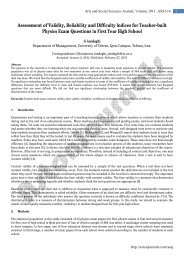
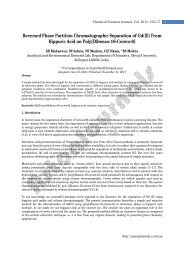
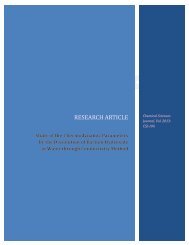
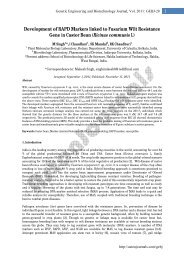
![[1,4]-benzodiazepine-2-one Derivatives as Potent - AstonJournals](https://img.yumpu.com/49117784/1/184x260/14-benzodiazepine-2-one-derivatives-as-potent-astonjournals.jpg?quality=85)
